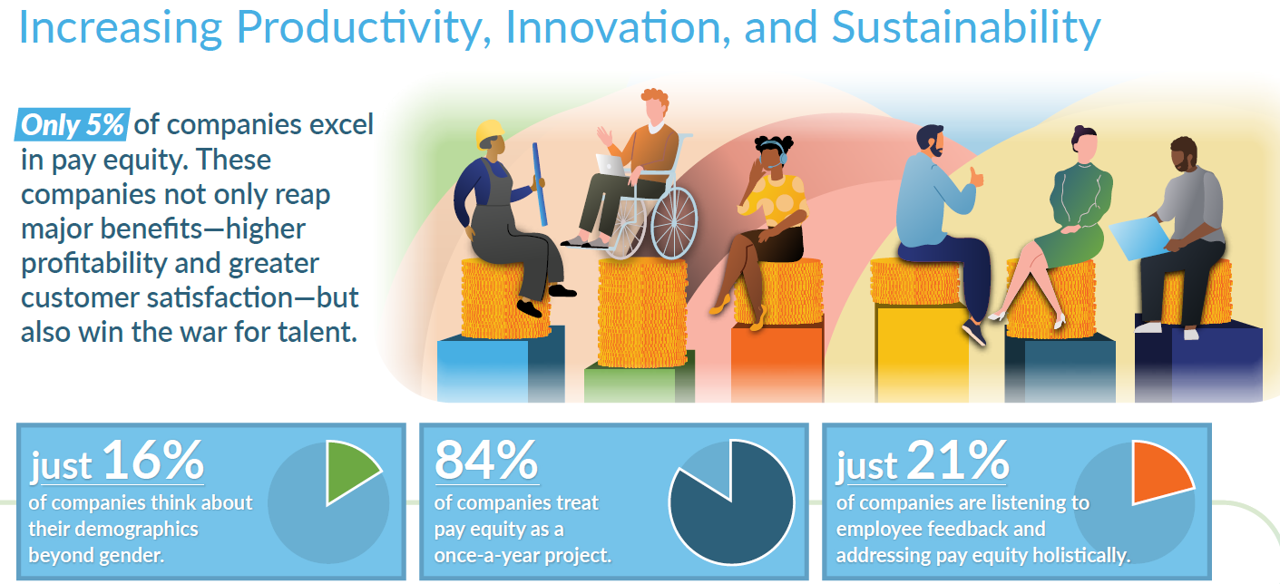How to solve pay equity through systemic HR
- 7 Min Read
Kathi Enderes, Senior Vice President of Research and Global Industry Analyst at The Josh Bersin Company, outlines how organizations can embrace systemic HR to create an effective strategy for pay equity that goes far beyond traditional limitations.
- Author: Kathi Enderes
- Date published: Aug 10, 2023
- Categories

Pay equity is not a new concept. It has been around as an aspiration for decades. Traditional approaches to pay equity focus primarily on the identification of existing pay disparities between men and women, in a once-a-year data analysis.
Indeed, only 5% of companies are effective in addressing pay equity. Effective approaches to pay equity go well beyond traditional ones:
- Beyond gender: Pay disparities can go beyond gender and include other factors like age, race, ethnicity, socio-economic background, and sexual orientation, as well as the intersectionality of these factors.
- Beyond base pay: Considering only base pay levels often does not tell a full story. Take bonus payments, incentive compensation, Long Term Incentives, stock, benefits, and other non-cash rewards when approaching pay equity.
- Beyond rewards: While rewards are the most visible results of inequities, they are never the root cause. Inequitable rewards come from decisions around hiring, promotions, succession, project staffing, learning opportunities, feedback and development, and performance management.
- Beyond a once-a-year project: If we only review pay equity once a year, we do not include the daily decisions around all talent processes that contribute to pay inequities, leaving the result to chance.
In this Q&A with HRD Connect, Kathi Enderes, Senior Vice President of Research and Global Industry Analyst at The Josh Bersin Company, outlines how organizations can embrace systemic HR to create an effective strategy for pay equity that goes far beyond traditional limitations.
1) Can you outline the fundamentals of systemic HR and the steps HR leaders can take to redesign their operating model?
Kathi Enderes: Systemic HR is a new way for the HR function to operate, breaking up the service delivery model where HR functions as an efficient service provider and instead serves as a problem-oriented consultant and business driver.
This means that each of the HR domains (e.g., talent acquisition, L&D, total rewards, DEI, talent and performance management, employee experience) no longer can perform in silos, but need to come together in agile SWAT teams around business issues.
This also impacts the roles and skills of HR professionals who need to have broader capabilities, be more data-savvy, and have a more consultative orientation.
2) What practical steps can organizations take to solve pay equity using a systemic HR model at scale?
Kathi Enderes: Pay equity is a systemic problem. Pay is the result of many decisions earlier in the talent chain: what do we offer as a starting salary, do we give a sign-on bonus, what project and learning opportunities does the person get, what feedback do we give, how do we assess their performance, for example.
And pay equity also touches people analytics, the employee experience, HR technology, and DEI. The way companies can approach pay equity is to bring together a cross-domain and cross-functional SWAT team which includes representatives from Total Rewards, TA, L&D, performance management, EX, DEI, people analytics, and HR technology as well as finance and legal, to work on a comprehensive strategy and ongoing plan.
Companies like SAP, CapitalOne, Microsoft, and Accenture make pay equity an important part of their business strategy.
3) Can you share an example of an organization using systemic HR to improve pay equity?
Kathi Enderes: Every company that has made measurable, sustained progress is using systemic HR approaches in pay equity – because the issues of pay equity are not just about pay.
Who do you hire and at what salary? How do you reward promotions? What is your performance management approach? Who gets the best learning opportunities, the biggest projects, and the most coveted assignments? How do you think about leadership and succession? How do you foster diversity and inclusion?
All these topics eventually manifest themselves in different pay levels.
SAP approached this problem as a systemic issue, bringing together a cross-functional team to address pay equity. As a result of dedicated systemic work, according to a global statistical analysis of pay equity, SAP paid 99% of its employees fairly for equal work in 2022. The initial salary adjustment cycle was so successful, that the company only needed to use 70% of the allocated budget to make fair pay adjustments the next time around.
4) How does AI augment help scale pay equity analysis and facilitate the application of systemic HR in practice?
Kathi Enderes: AI can help in many ways to support pay equity and facilitate systemic HR. On the compensation side, AI can perform the following functions.
- Pay audits: AI-powered algorithms can analyze large datasets quickly and efficiently, enabling organizations to conduct pay audits on a broader scale. These audits can identify pay disparities based on factors like gender, race, ethnicity, and other demographics, as well as identify potential areas of concern within the organization.
- Pay transparency: AI-powered tools can help organizations implement transparent pay structures by providing employees with data and insights about compensation benchmarks, factors that determine salary, and how their pay compares to colleagues in similar roles.
- Continuously monitor pay equity: AI algorithms can monitor compensation data on an ongoing basis, allowing organizations to track progress and make necessary adjustments to ensure that pay equity initiatives are effective and sustainable. This includes giving nudges before pay inequities occur.
- Inclusive job evaluation: AI can help create more inclusive job evaluation methods that consider a broader range of skills, responsibilities, and contributions, ensuring that roles primarily held by women or minority groups are appropriately valued.
- Predictive analytics for pay adjustments: AI can use predictive models to recommend appropriate pay adjustments. This may be based on factors such as performance, tenure, and market trends, reducing human biases and promoting fair treatment across the workforce.
- Identify hidden patterns and biases: AI can uncover subtle patterns and biases in compensation that might be difficult to detect manually. By analyzing various data points, such as performance metrics, education, experience, and other relevant factors, AI can reveal pay gaps that organizations have often overlooked in traditional approaches.
5) And how about beyond equity in compensation?
Kathi Enderes: Beyond compensation, AI can support equity in other processes:
- Mitigate unconscious bias: Unconscious biases influence traditional human decision-making processes. By properly designing and training AI systems, we reduce such biases by making objective and data-driven decisions related to hiring, promotions, performance management, and learning (in addition to pay).
- Objective performance reviews and feedback: AI-driven performance evaluation tools can help standardize the assessment process, making it less susceptible to subjective biases that might impact salary decisions.
- Inclusive goals: AI can help calibrate goals across groups to make sure performance goals are set fairly and equitably, which helps make the performance management processes fairer.
- Support fair negotiations: AI-based salary negotiation tools can help employees, especially those from historically marginalized groups, understand fair market rates for their skills and experience. This knowledge can empower them to negotiate equitable compensation during hiring or salary review processes.
It’s important to note that AI is not a panacea and that biased data will lead to biased results (“algorithmic bias”). HR and leaders need to monitor the results of AI and fully take accountability for the outcomes of AI.
6) How does the interconnectedness of systemic HR help to solve pay equity as a business-wide issue?
Kathi Enderes: According to our recent pay equity study, 71% of CEOs see pay equity as an urgent business imperative, but only 5% of companies are effective in addressing pay equity.
When companies realize that pay equity is not a pay problem, but an opportunity to define equity for the organization, they can leverage the systemic HR approach to seize the business benefits.
_______________
Kathi Enderes is Senior Vice President of Research and Global Industry Analyst at The Josh Bersin Company.











